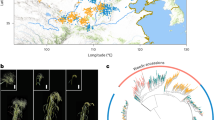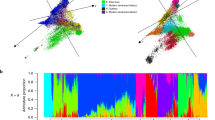Abstract
Foxtail millet (Setaria italica) is an important grain crop that is grown in arid regions. Here we sequenced 916 diverse foxtail millet varieties, identified 2.58 million SNPs and used 0.8 million common SNPs to construct a haplotype map of the foxtail millet genome. We classified the foxtail millet varieties into two divergent groups that are strongly correlated with early and late flowering times. We phenotyped the 916 varieties under five different environments and identified 512 loci associated with 47 agronomic traits by genome-wide association studies. We performed a de novo assembly of deeply sequenced genomes of a Setaria viridis accession (the wild progenitor of S. italica) and an S. italica variety and identified complex interspecies and intraspecies variants. We also identified 36 selective sweeps that seem to have occurred during modern breeding. This study provides fundamental resources for genetics research and genetic improvement in foxtail millet.
This is a preview of subscription content, access via your institution
Access options
Subscribe to this journal
Receive 12 print issues and online access
$209.00 per year
only $17.42 per issue
Buy this article
- Purchase on Springer Link
- Instant access to full article PDF
Prices may be subject to local taxes which are calculated during checkout



Similar content being viewed by others
Accession codes
References
Barton, L. et al. Agricultural origins and the isotopic identity of domestication in northern China. Proc. Natl. Acad. Sci. USA 106, 5523–5528 (2009).
Bettinger, R.L., Barton, L. & Morgan, C. The origins of food production in north China: a different kind of agricultural revolution. Evol. Anthropol. 19, 9–21 (2010).
Doust, A.N., Kellogg, E.A., Devos, K.M. & Bennetzen, J.L. Foxtail millet: a sequence-driven grass model system. Plant Physiol. 149, 137–141 (2009).
Brutnell, T.P. et al. Setaria viridis: a model for C4 photosynthesis. Plant Cell 22, 2537–2544 (2010).
Li, P. & Brutnell, T.P. Setaria viridis and Setaria italica, model genetic systems for the Panicoid grasses. J. Exp. Bot. 62, 3031–3037 (2011).
Lata, C., Gupta, S. & Prasad, M. Foxtail millet: a model crop for genetic and genomic studies in bioenergy grasses. Crit. Rev. Biotechnol. published online, http://dx.doi.org/10.3109/07388551.2012.716809 (18 September 2012).
Doust, A.N., Devos, K.M., Gadberry, M.D., Gale, M.D. & Kellogg, E.A. Genetic control of branching in foxtail millet. Proc. Natl. Acad. Sci. USA 101, 9045–9050 (2004).
Doust, A.N., Devos, K.M., Gadberry, M.D., Gale, M.D. & Kellogg, E.A. The genetic basis for inflorescence variation between foxtail and green millet (poaceae). Genetics 169, 1659–1672 (2005).
Wang, C. et al. Population genetics of foxtail millet and its wild ancestor. BMC Genet. 11, 90 (2010).
Wang, C. et al. Genetic diversity and population structure of Chinese foxtail millet (Setaria italica (L.) Beauv.) landraces. G3 (Bethesda) 2, 769–777 (2012).
Bennetzen, J.L. et al. Reference genome sequence of the model plant Setaria. Nat. Biotechnol. 30, 555–561 (2012).
Zhang, G. et al. Genome sequence of foxtail millet (Setaria italica) provides insights into grass evolution and biofuel potential. Nat. Biotechnol. 30, 549–554 (2012).
Weigel, D. & Mott, R. The 1001 genomes project for Arabidopsis thaliana. Genome Biol. 10, 107 (2009).
Gan, X. et al. Multiple reference genomes and transcriptomes for Arabidopsis thaliana. Nature 477, 419–423 (2011).
Schneeberger, K. et al. Reference-guided assembly of four diverse Arabidopsis thaliana genomes. Proc. Natl. Acad. Sci. USA 108, 10249–10254 (2011).
Huang, X. et al. Genome-wide association studies of 14 agronomic traits in rice landraces. Nat. Genet. 42, 961–967 (2010).
Huang, X. et al. Genome-wide association study of flowering time and grain yield traits in a worldwide collection of rice germplasm. Nat. Genet. 44, 32–39 (2012).
Lin, Z. et al. Parallel domestication of the Shattering1 genes in cereals. Nat. Genet. 44, 720–724 (2012).
Kang, H.M. et al. Variance component model to account for sample structure in genome-wide association studies. Nat. Genet. 42, 348–354 (2010).
Buckler, E.S. et al. The genetic architecture of maize flowering time. Science 325, 714–718 (2009).
Atwell, S. et al. Genome-wide association study of 107 phenotypes in Arabidopsis thaliana inbred lines. Nature 465, 627–631 (2010).
Higgins, J.A., Bailey, P.C. & Laurie, D.A. Comparative genomics of flowering time pathway using Brachypodium distachyon as model for the temperate grasses. PLoS ONE 5, e10065 (2010).
Singh, M. et al. Activator mutagenesis of the pink scutellum1/viviparous7 locus of maize. Plant Cell 15, 874–884 (2003).
Saitoh, K., Onishi, K., Mikami, I., Thidar, K. & Sano, Y. Allelic diversification at the C (OsC1) locus of wild and cultivated rice: nucleotide changes associated with phenotypes. Genetics 168, 997–1007 (2004).
Radicella, J.P., Turks, D. & Chandler, V.L. Cloning and nucleotide sequence of a cDNA encoding B-Peru, a regulatory protein of the anthocyanin pathway in maize. Plant Mol. Biol. 17, 127–130 (1991).
Yano, M. et al. Hd1, a major photoperiod sensitivity quantitative trait locus in rice, is closely related to the Arabidopsis flowering time gene CONSTANS. Plant Cell 12, 2473–2484 (2000).
Morrell, P.L., Buckler, E.S. & Ross-Ibarra, J. Crop genomics: advances and applications. Nat. Rev. Genet. 13, 85–96 (2011).
Hufford, M.B. et al. Comparative population genomics of maize domestication and improvement. Nat. Genet. 44, 808–811 (2012).
Huang, X. et al. A map of rice genome variation reveals the origin of cultivated rice. Nature 490, 497–501 (2012).
Konishi, S. et al. An SNP caused loss of seed shattering during rice domestication. Science 312, 1392–1396 (2006).
Meuwissen, T.H.E., Hayes, B.J. & Goddard, M.E. Prediction of total genetic value using genome-wide dense marker maps. Genetics 157, 1819–1829 (2001).
Kozarewa, I. et al. Amplification-free Illumina sequencing-library preparation facilitates improved mapping and assembly of (G+C)-biased genomes. Nat. Methods 6, 291–295 (2009).
Mullikin, J.C. & Ning, Z. The phusion assembler. Genome Res. 13, 81–90 (2003).
de la Bastide, M. & McCombie, W.R. Assembling genomic DNA sequences with PHRAP. Curr. Protoc. Bioinformatics Chap. 11 unit 11.14 (2007).
Kurtz, S. et al. Versatile and open software for comparing large genomes. Genome Biol. 5, R12 (2004).
Rice, P., Longden, I. & Bleasby, A. EMBOSS: the European Molecular Biology Open Software Suite. Trends Genet. 16, 276–277 (2000).
Barrett, J.C., Fry, B., Maller, J. & Daly, M.J. Haploview: analysis and visualization of LD and haplotype maps. Bioinformatics 21, 263–265 (2005).
Churchill, G.A. & Doerge, R.W. Empirical threshold values for quantitative trait mapping. Genetics 138, 963–971 (1994).
Felsenstein, J. PHYLIP: Phylogeny Inference Package (version 3.2). Cladistics 5, 164–166 (1989).
Acknowledgements
We thank J. Chen from the Institute of Genetics and Developmental Biology, Chinese Academy of Sciences, for discussion about the manuscript. We thank Z. Ning for assistance with sequence alignment. This work was supported by the China Agricultural Research System (CARS07-12.5-A02), the National Natural Science Foundation of China (31171560, 30630045 and 31121063), the National High Technology Research and Development Program of China (863 Program) (2013AA102603), the National Fund for Genetically Modified Organisms of China (2009ZX08009-093B), the Ministry of Agriculture of China (2011ZX08009-002) and the Chinese Academy of Sciences.
Author information
Authors and Affiliations
Contributions
B.H., X.D. and J. Li conceived the project and its components. H.Z., P.L., B. Zhao and X.D. collected samples. H.Z., G.J., H. Liu, Y.C., Y. Li, E.G., Shujun Wang, J.L., Suying Wang, W.Z., G.C., B. Zhang, L.Y., H.H., Y.W., Wei Li, N.Z. and H. Li performed the phenotyping. L.Z. contributed to evolutionary and functional analyses. G.J., Wenjun Li, Y.G., Y. Lu, C. Zhou, D.F., Q.W. and Q.F. performed the genome sequencing. X.H. and Y.Z. performed GWAS and population genetics analysis. Q.Z., K.L., H. Lu, C. Zhu, T.H., L.Z. and T.L. performed genome data analysis. Y.Z. and X.H. prepared figures and tables. X.H., X.D. and B.H. analyzed the total data and wrote the paper.
Corresponding authors
Ethics declarations
Competing interests
The authors declare no competing financial interests.
Supplementary information
Supplementary Text and Figures
Supplementary Figures 1–54, Supplementary Tables 2–15 (PDF 15733 kb)
Supplementary Table 1
The list of 916 foxtail millet accessions (Setaria italica) sampled in the collection. (XLS 163 kb)
Rights and permissions
About this article
Cite this article
Jia, G., Huang, X., Zhi, H. et al. A haplotype map of genomic variations and genome-wide association studies of agronomic traits in foxtail millet (Setaria italica). Nat Genet 45, 957–961 (2013). https://doi.org/10.1038/ng.2673
Received:
Accepted:
Published:
Issue Date:
DOI: https://doi.org/10.1038/ng.2673
This article is cited by
-
Efficient identification of QTL for agronomic traits in foxtail millet (Setaria italica) using RTM- and MLM-GWAS
Theoretical and Applied Genetics (2024)
-
Identification of a QTL for Setaria italica bristle length using QTL-seq
Genetic Resources and Crop Evolution (2024)
-
Genetic diversity of grain yield traits and identification of a grain weight gene SiTGW6 in foxtail millet
Theoretical and Applied Genetics (2024)
-
Comparative transcriptome analysis and genetic dissection of vegetative branching traits in foxtail millet (Setaria italica)
Theoretical and Applied Genetics (2024)
-
Multi-environment GWAS identifies genomic regions underlying grain nutrient traits in foxtail millet (Setaria italica)
Plant Cell Reports (2024)



